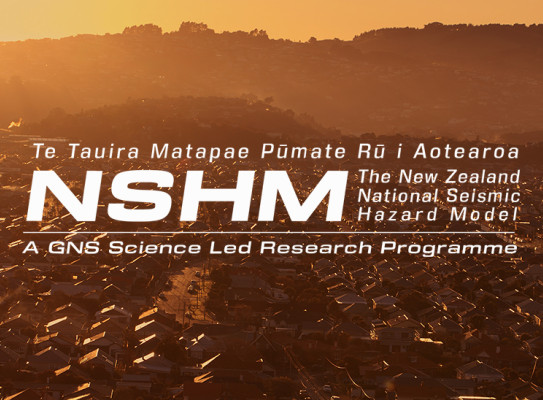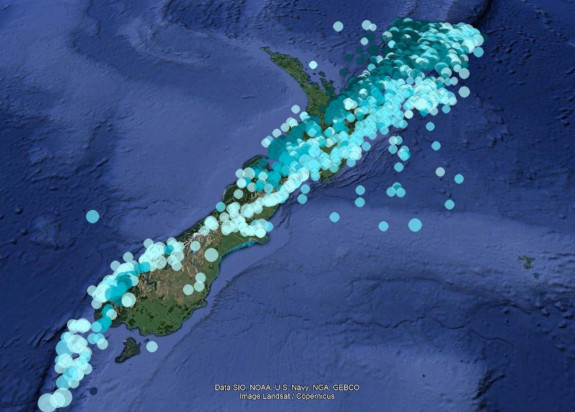
Aotearoa New Zealand’s earthquake resilience boosted by release of new hazard model

The National Seismic Hazard Model estimates the likelihood of future earthquake shaking hazard to have increased throughout most of the country, ranging from almost no change to more than doubling in some areas.
On average, results have increased by 50 percent or more from previous modelling, highlighting the need to boost national resilience strategies and readiness.
Led by a team from GNS Science, more than 50 local and international scientists have been collaborating for more than two years on the revision of the National Seismic Hazard Model(external link), which was made publicly available this week.
An important part of New Zealand’s hazard-scape toolkit, the National Seismic Hazard Model (NSHM) provides an estimate of the likelihood and strength of earthquake ground shaking at any given site in New Zealand, and considers how different parts of the country might behave in the event of large magnitude earthquakes.
Explaining the National Seismic Hazard Model 2022 transcript
Aotearoa New Zealand sits aside tectonic plates and that puts the country at risk of earthquakes.
Knowing how strong future earthquakes shaking might be helps us to understand the risks to our communities.
The more we know, the better we can prepare, make good decisions, and increase our resilience to earthquake hazard events.
And the world is continually learning with new information resulting from every new earthquake event.
Developed using the best available science in the world,
the New Zealand National Seismic Hazard Model is our future earthquake knowledge toolkit.
The National Seismic Hazard Model is a science based, agreed estimate of the likelihood and strength of earthquake shaking throughout New Zealand.
It's a detailed model to help decision makers manage the risks, the losses due to earthquakes throughout New Zealand.
The New Zealand Seismic Hazard Model is an amalgam of many models.
It incorporates, I don't know, thousands of different models of earthquake occurrence over different time frames, looking at it from different angles, and it's all there to bring together the most comprehensive view and understanding of earthquake occurrence throughout New Zealand.
So the National Seismic Hazard Model is a probabilistic model, and why that's important is because it's not earthquake predictions.
We can't predict earthquakes.
We don't have the understanding to be able to do that.
So the reason it's probabilistic
is because that's the way that we can bring in a broad range of our scientific understanding and put that into a form that can be understood by others and used for decision making.
With this science New Zealand decision makers such as the Ministry of Business, Innovation and Employment,
Toka Tū Ake EQC, local government and our emergency management agencies can make informed decisions in our policy and practice.
The University of Canterbury is a major contributor to the National Seismic Hazard Model project, along with many other tertiary and crown research institutions in New Zealand and in combination with a significant number of international partners.
We've learned significant new aspects of the earthquakes, particularly on the backbone of the 2010 and 2011
Canterbury earthquakes as well as the 2016 Kaikoura earthquake.
Some of the important things that we've learned is increased understanding of the nature of earthquakes and the complexity of earthquakes.
We saw in the Canterbury and Kaikoura earthquakes how individual faults can connect together to cause complicated earthquake sequences, and the new New Zealand National Seismic Hazard Model has the ability to account for such complexity in earthquake occurrence.
It will lead to significant improvements in our ability to forecast the nature and strength of earthquake induced ground motion shaking, which will lead to more efficient design of societal infrastructure so that we can find the right balance between upfront costs to build resilience and the long term impacts of that resilience.
One of the big advantages that we have now is the availability of high performance computing and how we can run much more complex models than we could have done in the past to account for many more things that are happening in the earth and to account for much greater uncertainties.
We model hundreds of thousands of potential earthquakes around the country and these earthquakes connect up different faults in the system and looks at how they may interact together.
And there's the big ones, like everybody knows about the Alpine fault, the Wellington fault, and of course, the Hikurangi, which we've learned a lot about the subduction zone in the last 10 or 20 years.
Those are those are big, important Earthquake sources for the future of New Zealand, but there's also many other potential earthquake sources around the country.
One of the things that's been quite important to us as we've been putting the model together, is that anything we're doing, we want to make sure is openly available to anyone who might want to use it or is interested in it or needs to use it. So all of the outputs of the model, the model itself, all of that is is easily available. It's available online.
You can look at different maps.
You can look at special technical curves that engineers might be interested in.
There's a whole lot of different ways you can look at what's come out of the model and how that may be important to you and where you particularly live.
We've been working on the seismic hazard model for a couple of years now.
It's involved a team of 50 or 60 scientists and engineers nationally, internationally recognized, and that was super important, so we could enfold, we can take on board scientific understanding throughout the globe on how it impacts our assessment of ground shaking throughout New Zealand.
Knowing as much as we can about earthquake
hazards and risk is only one part of New Zealand's safety plan.
The next is integrating that knowledge with the people who can use that information.
Estimating the likely impact of future earthquakes on New Zealand land, buildings, infrastructure and people is essential to help us be as safe and as prepared as we can be.
Explaining the National Seismic Hazard Model 2022
Aotearoa New Zealand sits aside tectonic plates and that puts the country at risk of earthquakes....
Funded by MBIE and Toka Tū Ake EQC, the NSHM project incorporates the latest international science and considers the data and knowledge resulting from New Zealand’s significant earthquakes of the last two decades, such as the Canterbury earthquake sequence and the Kaikōura earthquakes
Dr Matt Gerstenberger, GNS Science NSHM Project Lead says it is critical to have an up-to-date understanding of the seismic hazards facing New Zealand to help us manage the risks from earthquakes to people, property and the environment.
The increase in hazard estimates in the 2022 revision is not unexpected. We know a lot more about earthquake behaviour now due to better global understanding, more sophisticated science, and more than a decade of advancements in technical computing.
"Knowing more means we have the ability to make better estimates, allowing various industries who use the model to assess what the hazard results might mean for different locations, and then act to mitigate risks,” Dr Gerstenberger said.
Earthquake hazard varies throughout the country based on the geography and ground conditions in each location, and the frequency and types of earthquakes which might occur.


While the NSHM indicates a general increase in forecast ground shaking hazard across the country, it does not describe its impact, or assess associated risk. Instead, the model is a science instrument which can be used by government and industry to estimate risk and help make risk-based decisions.
When we look at the hazard results for a particular area, it’s important to stress that increased hazard doesn’t necessarily mean a larger impact.
“The impact of ground shaking does not necessarily increase equally to the hazard, because the impact on society includes many additional factors that are not part of the science model - like building aspects and structure design – and the National Seismic Hazard Model doesn’t address those,” Dr Gertenberger explains.
“When interpreting how the hazard results have changed from previous models, we need to consider the relative value of the shaking forecast. For example, if there has been a doubling in hazard in a region with a previously very low estimated hazard, then the updated hazard – though greater – may still be low.
“Northland is a good example of this, where the ground shaking hazard is now estimated at twice its previous known level, but it can still be considered a very low hazard risk region.”
Time will be required to determine how the revised hazard information will factor into policy and practice. The engineering, building and insurance industries will all now be analysing the NSHM data and carefully considering how it might be applied.
Throughout the revision project, technical advice on the development of the NSHM has been provided by a 17-member panel of international scientists and engineers using a participatory review process. An additional 5-member international panel then undertook an assurance review of the science process.
The panel determined that the project team has done an outstanding job in incorporating the best available science, engaging the highest-level relevant expertise among numerous organisations worldwide, and navigating the project around pandemic-related constraints.
The NSHM is freely available HERE(external link) with video and fact sheets provided to help explain the detailed science and regional summaries to outline the key information for different locations.
